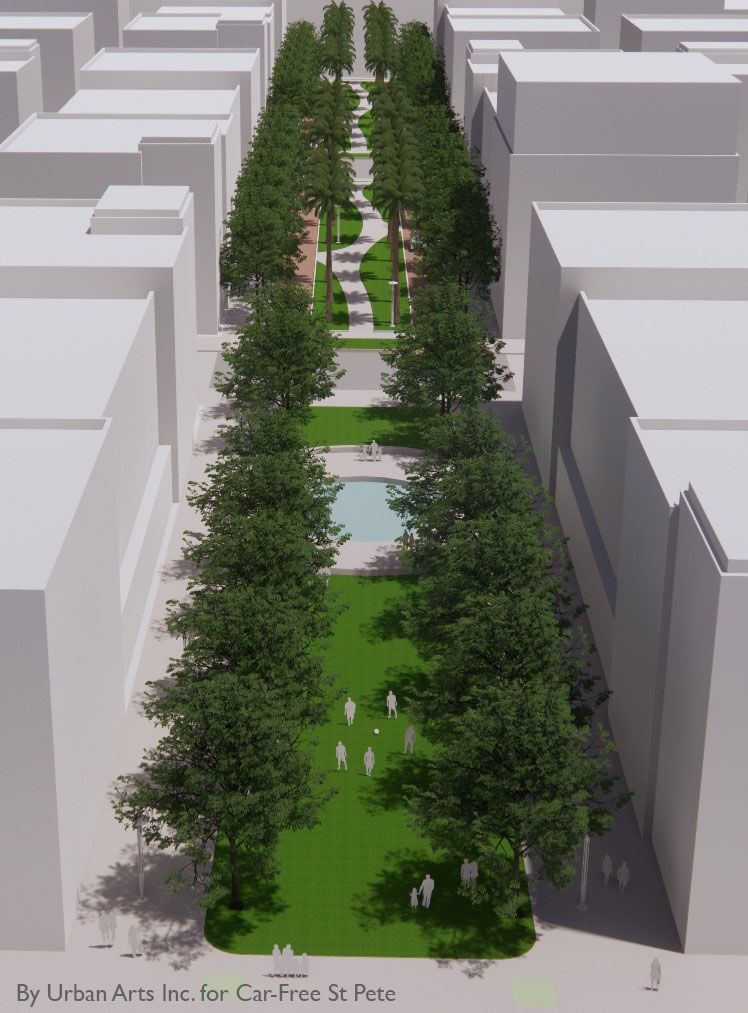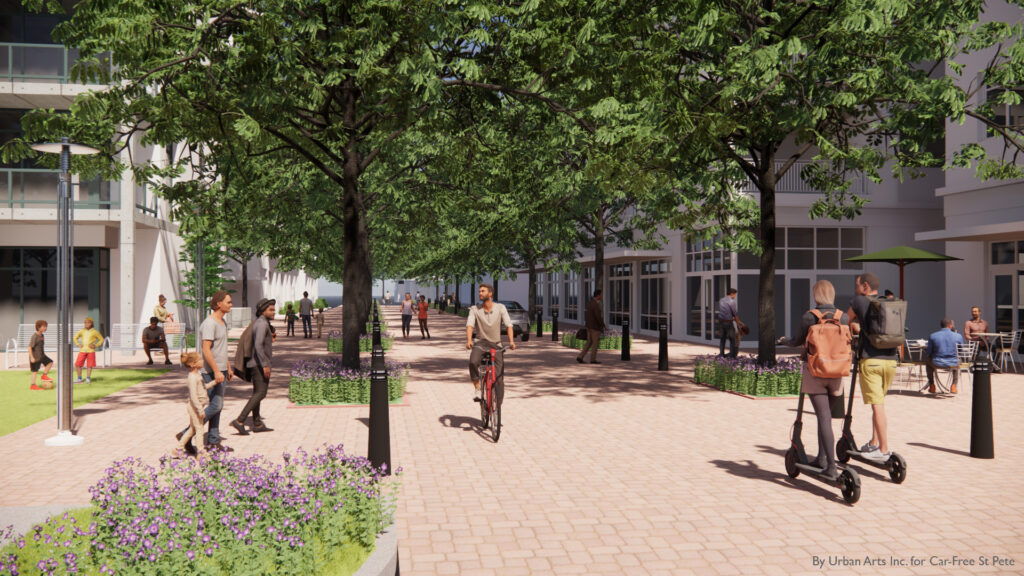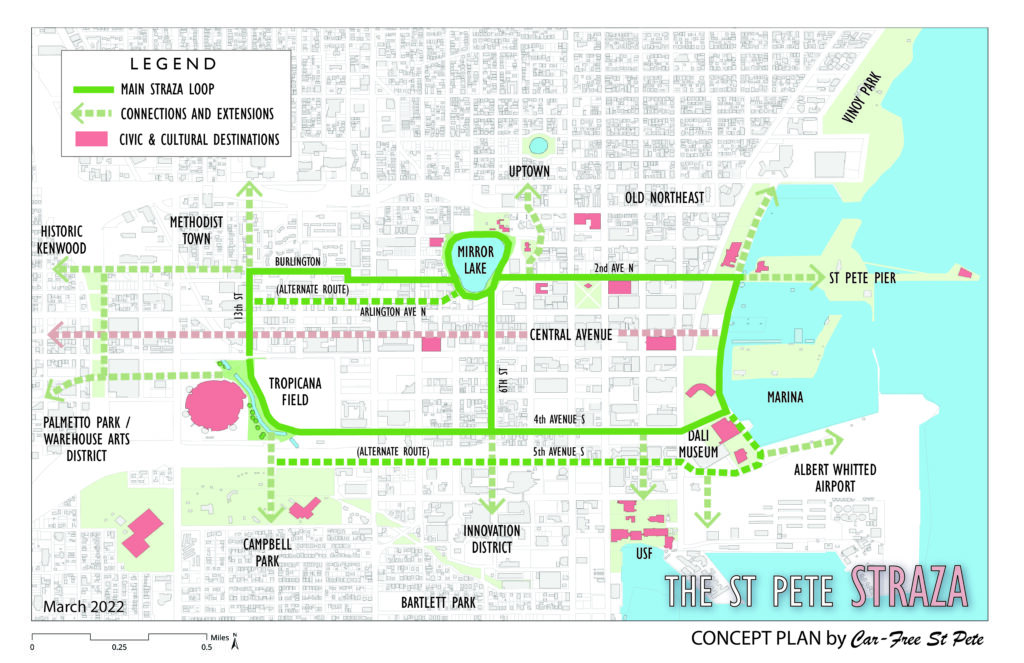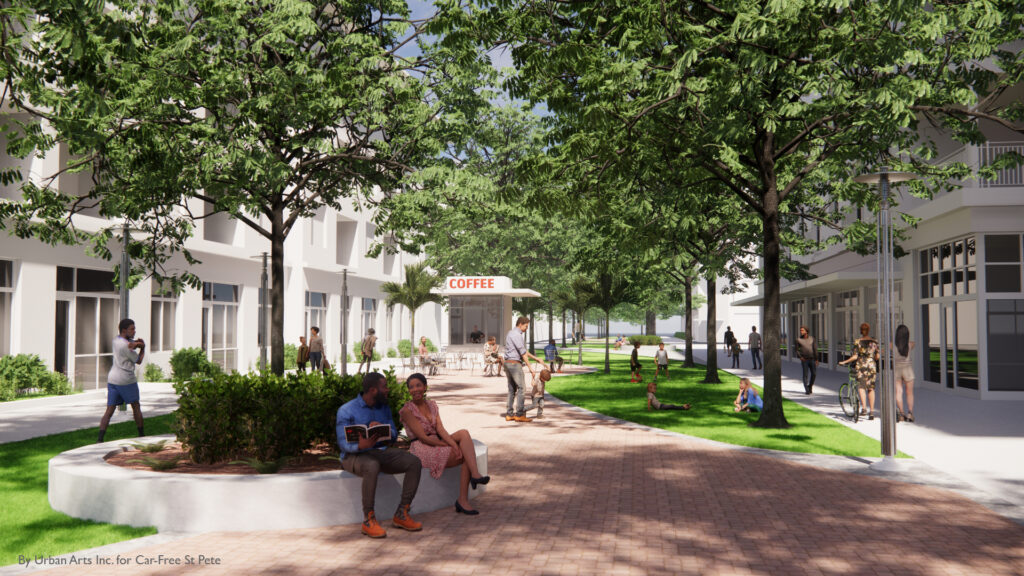The St. Pete Straza is the next big idea the Car-Free St. Pete Committee is working on. We are proposing a three-plus mile loop that combines the elements of a street, plaza, and park. It would transform automobile dominated streets in downtown into a more comfortable environment for people to walk, stroll, play, and create community. This would be accomplished by transforming existing streets to prioritize pedestrian activity by removing curbs, expanding sidewalks, adding landscaping, and slowing cars to speeds that are compatible with pedestrian activities.
We believe this aspirational project, if supported and created by the community, will help us to achieve our goal of fewer car trips due to more viable alternative transportation options as well as improved streets and open spaces to enhance the experience of residents and visitors that choose to walk, bike, use transit, and safe forms of micro-mobility.
The name “Straza,” coined by urban planner with Urban Arts Inc. and Car-Free St. Pete Committee Member Michael Huston, is derived from combining the terms “street” and “plaza”. Thus, as the name implies, the Straza has elements of both. It facilitates mobility (in this case prioritizing pedestrian mobility) like a street, and acts as an informal gathering place like a plaza. The name Straza is not trademarked, and we encourage other cities to adopt the terminology and develop their own versions of this big idea!
We anticipate that some parts of the Straza may be pedestrian-only, while other parts will allow vehicular access but at reduced speeds. This will be determined as the project moves through the feasibility and planning phases. The study will ensure that emergency access and other essential services will not be impeded by the design of the project. These decisions will be made as part of a public planning process.

No. We have a preliminary plan, but nothing is set in stone. We want to connect major destinations, like the Dali Museum, Waterfront, and Tropicana Field but the exact route would not be determined until more study is conducted. We see this as an opportunity to connect the north, south, east and west sides of downtown in a way that Central Avenue cannot. In addition, the preliminary plan shows several branches that potentially could extend into existing neighborhoods and districts to better connect all areas of our community.
The implementation is expected to occur incrementally over time. Once the plan is studied and adopted, sections of the Straza could be constructed as funding becomes available or in public/private partnership as part of new developments (such as the Tropicana Field redevelopment, where a Booker Creek linear park system has been recommended to link existing and additional bike trails throughout the city). It is anticipated that as the completed sections show signs of success, momentum will build to fill in the missing gaps and complete the entire loop. This has happened in other cities with similar ambitious projects such as Atlanta’s Beltline.
On the street level, we plan to transform existing streets to prioritize pedestrian activity by removing curbs, expanding sidewalks, adding landscaping, and slowing cars to speeds that are compatible with pedestrian activities.
The overall cost has not been determined yet. Currently the Straza is an aspirational idea that needs to be explored with a feasibility study before costs can be estimated – this in an important next step. The good news is that the investment will pay off in increased value, tourism, and enhanced quality of life for all St. Pete residents. The Straza will be an amenity that all can enjoy whether they live in downtown or not.

We all love Central Avenue and want to see it continue to succeed and evolve into something even better. The preliminary route of the STRAZA intersects with Central Avenue is three locations. The vision for the Straza is substantially different than Central Avenue. The Straza will be quieter, more park-like, and less dependent on commercial activity. There may be shops and cafes located here and there, but it is not intended to be a continuous commercial corridor like Central Avenue. In this way, it should complement, not compete with, Central Avenue.
Yes! There are many communities around the country and the world that are prioritizing their streets to create pedestrian safe spaces that encourages active mobility as well as economic activity. In 2018, Clematis Street in Downtown West Palm Beach began being rebuilt as a “Shared Street”. Improvements to the historical heart of the city provide more shade trees, wider sidewalks, more seating and street amenities to its patrons. It is completely curbless and devised to slow down traffic. Retractable bollards allow for an adaptable street where sections are easily closed to auto traffic and flexible curbside management combines cafe’ seating, on-street parking, bike parking and ride-hailing pickup and drop off.
Currently, the city of Portland is working on their six-mile “Green Loop”. The city’s website describes the Green Loop as follows: “It’s a new way for people to be in the Central City … active, safe and fun. Whether on foot, bike or mobility device, people of all ages and abilities will be able to use the Green Loop to get to work, go for a jog, shop, eat out, play, and meet friends for lunch or a concert in a park.” Depending on the investment in the project, studies predict that Green Loop could create between 156 to 783 full-time equivalent jobs, and generate between $22 to $114 million in economic output, concentrated in construction, architecture, engineering, and related services, and food services industry sectors.


We are trying to gather support from residents and our city leaders in order to build momentum for the idea. We are also advocating for a downtown master plan that would extend beyond the current Waterfront Plan and capture the entire downtown area. If a master plan is not an option, a feasibility study would be conducted to examine possible routes, establish cost estimates, and set basic design standards.
The Straza will provide yet another public amenity for citizens of St Petersburg, a place to walk your dog, take a stroll with friends, and enjoy an urban environment free of the noise, pollution and danger caused by moving traffic. It will promote healthy living by encouraging folks to walk more and drive less. It will support local businesses that will take advantage of the increase in pedestrian activity. As part of the downtown network, it will encourage the car-free lifestyle as an alternative to Tampa Bay’s car dominated environment. And it will become a model for other cities to follow as we move toward more sustainable urban planning.
Please share your feedback by clicking here or email us at [email protected] to let us know if you would like the Car-Free St. Pete Committee to present the St. Pete Straza concept to your group or organization.